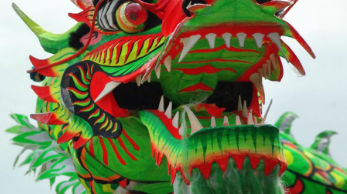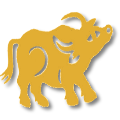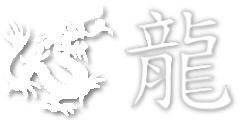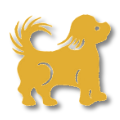Saturday, February 10, 2024 marks the beginning of a new lunar year.
 Celebrated throughout the world as Chinese New Year, Lunar New Year, or Spring Festival (春节; pinyin: Chūnjié), Lunar New Year typically falls on the second new moon after the winter solstice. It's based on the Chinese Lunisolar calendar (which indicates both the moon phase and the position of the sun in the Earth's sky. This new year welcomes the Year of the Dragon. In China and elsewhere, New Year customs vary, though most of the traditions remain. For example, on the days immediately before the New Year celebration, most Chinese families give their homes a thorough cleaning to sweep away the bad luck of the preceding year and make their homes ready for good luck. Brooms and dust pans are put away on the first day so that the newly arrived good luck cannot be then swept away.
Celebrated throughout the world as Chinese New Year, Lunar New Year, or Spring Festival (春节; pinyin: Chūnjié), Lunar New Year typically falls on the second new moon after the winter solstice. It's based on the Chinese Lunisolar calendar (which indicates both the moon phase and the position of the sun in the Earth's sky. This new year welcomes the Year of the Dragon. In China and elsewhere, New Year customs vary, though most of the traditions remain. For example, on the days immediately before the New Year celebration, most Chinese families give their homes a thorough cleaning to sweep away the bad luck of the preceding year and make their homes ready for good luck. Brooms and dust pans are put away on the first day so that the newly arrived good luck cannot be then swept away.
The evening preceding the New Year's Day is an occasion for families to gather for an annual reunion dinner, which traditionally includes dishes of pork, chicken, and fish. Red packets for the immediate family are often distributed during the reunion dinner. These packets contain money and are usually given from older people to younger ones. Small gifts are also exchanged between friends or relatives of different households.
In China, celebrations last up to 16 days, though only the first seven days are considered a public holiday. Lunar new year celebrations, both official and informal, vary throughout other Asian countries and wherever there is a significant Chinese population or heritage.
Other New Year Celebrations
Lunar New Year
Not all Asian countries use the lunar calendar, but Lunar New Year is celebrated wherever there is a significant Chinese population or cultural heritage. Each country has adapted the holiday to its own culture. Major celebrants include:
Taiwan
Celebration of Lunar New Year is perhaps the most important of all of Taiwan’s traditional holidays and certainly its longest. Since most of the Taiwanese population is Chinese, Lunar New Year is celebrated in a similar fashion to mainland China. While many East Asian holidays are not oriented around food, Chinese New Year feast is one of the most anticipated occasions in Taiwan. Prior to this event, Taiwanese family members, and sometimes friends, reunite and enjoy a large meal of traditional Chinese foods, including pork dumplings, rice, steamed fish, chicken, and noodles.
Korea
 Seollal (설날) is a festival and national holiday commemorating the first day of the lunisolar calendar. It is one of the most important traditional holidays in both North and South Korea. The celebration usually lasts three days: the day before New Year, New Year itself, and the day after New Year. During this time, Koreans visit family, perform ancestral rites, eat special meals, including Korean Chinese cuisine, and play folk games. In some years, Korean New Year may actually occur the day after Chinese New Year. (This last occurred in 2009, and will occur again in 2033.) Why? The beginning of a lunar month is the day on which a new moon appears. Since Korea is one hour ahead of China, it may already be the next day, if the exact moment a new moon occurs is around midnight.
Seollal (설날) is a festival and national holiday commemorating the first day of the lunisolar calendar. It is one of the most important traditional holidays in both North and South Korea. The celebration usually lasts three days: the day before New Year, New Year itself, and the day after New Year. During this time, Koreans visit family, perform ancestral rites, eat special meals, including Korean Chinese cuisine, and play folk games. In some years, Korean New Year may actually occur the day after Chinese New Year. (This last occurred in 2009, and will occur again in 2033.) Why? The beginning of a lunar month is the day on which a new moon appears. Since Korea is one hour ahead of China, it may already be the next day, if the exact moment a new moon occurs is around midnight.
Vietnam
 Tết Nguyên Đán (Hán Nôm: 節元旦) the Vietnamese Lunar New Year, is one of the most important celebrations in Vietnamese culture. Popularly known as Tết, it also is an occasion for family reunions — an opportunity to set aside the trouble of the past year and hope for a better and happier upcoming year. Vietnamese people usually return to their families during Tết. Customs and traditions include visiting relatives, friends and neighbors, cooking special holiday food and cleaning house, giving lucky money to children and elderly people, and showing respect to ancestors by visiting and cleaning graves. Due to time zone differences, Tết is occasionally the day before the Chinese one.
Tết Nguyên Đán (Hán Nôm: 節元旦) the Vietnamese Lunar New Year, is one of the most important celebrations in Vietnamese culture. Popularly known as Tết, it also is an occasion for family reunions — an opportunity to set aside the trouble of the past year and hope for a better and happier upcoming year. Vietnamese people usually return to their families during Tết. Customs and traditions include visiting relatives, friends and neighbors, cooking special holiday food and cleaning house, giving lucky money to children and elderly people, and showing respect to ancestors by visiting and cleaning graves. Due to time zone differences, Tết is occasionally the day before the Chinese one.
Others
Lunar New Year is officially known as "Chinese New Year" in Singapore, and it is a two-day public holiday (and unofficially a weeklong celebration). It is celebrated primarily by Chinese Singaporeans, who make up three-quarters of the population. Also called Chinese New Year in Malaysia, the national holiday is similar to that of Singapore’s in that it originated from a large Chinese immigrant community. Lunar New Year is recognized as a non-working holiday in the Philippines, although it is not celebrated by all Filipinos. In Indonesia, Lunar New Year, also called Imlek, was banned from being celebrated in Indonesia for many years. It wasn’t until 2002 that Indonesians and Chinese immigrants were allowed to celebrate it as a national holiday. And while Lunar New Year isn’t as big of a celebration in Cambodia and Thailand, they each have a significant Chinese population that participates in the holiday. Brunei, where about 10% of the population is Chinese, also celebrates Lunar New Year.
The Legend(s) of Nian

The first dated Chinese New Year celebration can be traced back to over 2,200 years ago, and it all started with a mythical beast called the Nian — a hideous monster who (perhaps) lived in a small province of Shanghai. The Nian has many descriptions, and it is often pictured as a cross between a lion, an ox, and a unicorn.
Here are two quick versions of the original tale:
The Nian lived in the sea and would surface once a year during the Spring Festival to feast on the local villagers. One year, an old beggar wandered into the village and agreed to stay the night—even as the villagers were fleeing to the mountains. The old man, who perhaps knew something about the Nian, posted red papers all over the village. As the Nian approached the village the next morning, the man, dressed all in red, set off firecrackers. Frightened, the monster quickly fled back to the sea. The villagers learned that the old man knew the Nian was afraid of the color red and of loud noises. So at the advent of the Spring Festival, the villagers would always thereafter wear red clothes, hang red lanterns and post red spring scrolls on windows and doors, and light firecrackers and bang drums to keep the Nian away.
The Nian lived in the mountains, and during winter, when animals hibernate or hide from the cold, the Nian would go hungry. So every lunar new year, just as spring was around the corner, he would descend from the mountains and prey on the nearby villagers—especially children. A wise old man living in the village thought it was the villagers’ panic that made the monster so bold. He organized the villagers to conquer the Nian by beating drums and gongs, burning bamboo, and lighting fireworks to threaten the beast. Wherever the Nian reappeared, the villagers burst out the noises and the fire — and the Nian was forced to run away. Eventually, the monster collapsed with exhaustion, and the villagers killed it.
However the story is told, Chinese celebrate Chinese New Year by setting off firecrackers, hanging red lanterns, wearing red clothing, and putting up red couplet poems on their doors that express hope and happiness for the coming year.
There be dragons.
There is more to the Chinese Zodiac than animal traits.
The Chinese zodiac, or Sheng Xiao (生肖), is a traditional classification scheme based on the lunar calendar that assigns an animal and its reputed attributes to each year in a repeating twelve-year cycle. In order, the zodiac animals are: Rat, Ox, Tiger, Rabbit, Dragon, Snake, Horse, Goat, Monkey, Rooster, Dog, Pig.
There are many versions of how this order came to be. The basic story is that a prominent Emperor (Jade or Yellow, depending on the source) summoned all the animals to his palace in a “Great Race” (or possibly for a Great Banquet). The order in which they arrived would determined their place in the zodiac. Just before the race's finish, the animals had to cross a river. Tiger, king of the beasts, was confident that no one could compete with its speed and vigor—though Ox was probably best suited to crossing the river. Rat, however, jumped on Ox’s shoulders — only to hop off once they’d crossed the river, thus finishing first. (One could argue that Rat either cheated or was simply the cleverest.) Either way, the king of the jungle had to settle for third.
The animal corresponding to one's birth year, though, is only one part of a Chinese zodiac profile.
The Chinese lunar canlendar is based on the combinition of 10 Heavenly Stems (Tian Gan) and 12 Earthly Branches (Di Zhi) — two basic groups of terms of ancient Chinese astronomy and astrology that work together in a fixed order to mark years, months, days, and hours.
The 12 Earthly Branches correspond with the 12 zodiac animals — Zi (Rat), Chou (Ox), Yin (Tiger), Mao (Rabbit), Chen (Dragon), Si (Snake), Wu (Horse), Wei (Sheep), Shen (Monkey), You (Rooster), Xu (Dog) and Hai (Pig). The 10 Heavenly Stems match the 12 Earthly Branches in a 60-pair cycle to mark years, months, and days.
Yin Yang: Yin means feminine and negative, while Yang means masculine and positive.Their simple connection with zodiac animals are: Yang applies to Rat, Tiger, Dragon, Horse, Monkey, and Dog, while Yin applies to Ox, Rabbit, Snake, Sheep, Rooster, and Pig.
Five Elements: Ancient Chinese believed that all things in the world belonged to five categories – Metal (Monkey, Rooster), Wood (Tiger, Rabbit), Water (Rat, Pig), Fire (Snake, Horse), and Earth (Ox, Dragon, Sheep, Dog).
12 Shi Chen: 12 two-hour periods form a day, with each called a Shi Chen and marked by one of the 12 Earthly Branches and its corresponding zodiac animal.
Though the 12 animals connect to people’s birth dates, it is the interactions with the above perspectives that affect people’s personalities, compatibilities, and fortunes.












